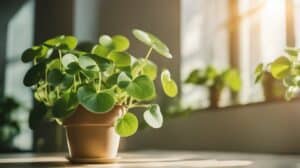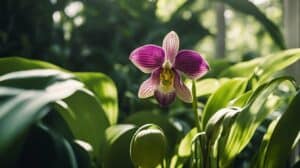Cordyline Australis, commonly known as the Cabbage Palm, is a popular ornamental plant native to New Zealand.
With its striking appearance and easy care requirements, it has become a favorite among beginner gardeners.
In this beginner’s guide, you will learn everything you need to know about growing and caring for the Cordyline Australis.

The Cordyline Australis is a slow-growing plant that can reach up to 20 feet in height.
It has long, sword-shaped leaves that can range in color from green to purple, and its trunk is topped with a cluster of leaves that resemble a cabbage.
While it is native to New Zealand, it can be grown in a variety of climates and soil types, making it a versatile plant for any garden.
Whether you are looking to add a tropical touch to your landscape or simply want to enjoy the beauty of this unique plant, the Cordyline Australis is a great choice for any beginner gardener.
Understanding Cordyline Australis
Origins and Characteristics
Cordyline Australis, commonly known as the Cabbage Palm, is a popular ornamental plant native to New Zealand.
It belongs to the Asparagaceae family and is a member of the Cordyline genus.
This plant is known for its striking, sword-shaped leaves that can grow up to 3 meters in length.
The leaves come in various shades of green, bronze, red, and purple, making it a popular choice for gardeners looking to add a splash of color to their landscapes.
In addition to its attractive foliage, Cordyline Australis also produces fragrant flowers that bloom in the summer.
The flowers grow on long spikes and are typically white or pink in color.
The plant can grow up to 20 meters tall in its natural habitat, but it is usually smaller when grown in gardens.
Varieties and Species
There are several varieties of Cordyline Australis, each with its own unique characteristics.
The most common variety is the Cordyline Australis ‘Red Star’, which has striking red leaves.
Other popular varieties include the Cordyline Australis ‘Purpurea’, which has purple leaves, and the Cordyline Australis ‘Atropurpurea’, which has dark red leaves.
Apart from the Cordyline Australis, there are other species of Cordyline, such as the Cordyline Fruticosa, which is native to Hawaii and the Pacific Islands.
This species is commonly known as the Ti plant and is used for medicinal and decorative purposes.
Overall, Cordyline Australis is a versatile and easy-to-grow plant that is suitable for both novice and experienced gardeners.
With its striking foliage and fragrant flowers, it is sure to add a touch of beauty to any garden or landscape.
Planting and Care

Ideal Soil Conditions
Cordyline Australis grows best in well-draining soil that is rich in organic matter. The ideal pH range for the soil is between 6.0 and 7.0.
It is important to avoid planting the cabbage palm in soil that is too heavy or compacted, as this can lead to poor growth and root rot.
If the soil in your area is not suitable, you can improve it by adding compost or other organic matter.
Sunlight and Watering Requirements
Cordyline Australis prefers full sun to partial shade, and requires at least six hours of direct sunlight per day.
When it comes to watering, it is important to keep the soil moist but not waterlogged.
Overwatering can lead to root rot, so it is best to water the plant when the top inch of soil feels dry to the touch.
During the winter months, the plant can tolerate drier soil conditions.
Fertilization and Pruning
Cordyline Australis benefits from regular fertilization during the growing season.
Use a balanced fertilizer with an N-P-K ratio of 10-10-10 or 20-20-20 every two to four weeks.
Pruning is not necessary for this plant, but you can remove any dead or damaged leaves to keep the plant looking neat and tidy.
Common Challenges

Pest and Disease Management
Cordyline Australis is generally a hardy plant, but it can still be susceptible to a few pests and diseases.
Here are some of the most common ones you may encounter:
- Scale insects: These tiny insects can infest the leaves and stems of your plant, causing yellowing and stunted growth.
You can control them by wiping the leaves with a damp cloth or using an insecticidal soap.
- Mealybugs: These pests look like small white cotton balls and can cause similar damage to scale insects.
You can control them with the same methods as scale insects.
- Fungal diseases: Cordyline Australis can be susceptible to leaf spot and root rot caused by fungal diseases.
Make sure to plant your cabbage palm in well-draining soil and avoid overwatering.
If you notice any signs of fungal disease, remove the affected leaves and treat the plant with a fungicide.
Weather-Related Concerns
Cordyline Australis is a hardy plant that can tolerate a range of weather conditions, but there are still a few things to keep in mind:
- Frost: While Cordyline Australis can tolerate some frost, prolonged exposure to freezing temperatures can damage the plant.
If you live in a cold climate, consider covering your plant with a frost cloth during the winter months.
- Wind: Cordyline Australis can tolerate wind, but strong gusts can damage the leaves and stems.
If you live in a windy area, consider planting your cabbage palm in a sheltered spot or providing some support with a stake.
- Drought: Cordyline Australis is drought-tolerant, but prolonged periods of dry weather can cause the leaves to wilt and turn brown.
Make sure to water your plant regularly during hot and dry weather.
Frequently Asked Questions

What are the ideal conditions for growing Cordyline australis outdoors?
Cordyline australis thrives in full sun to partial shade and prefers well-draining soil.
It can tolerate a range of soil types, from sandy to loamy, and is moderately drought-tolerant once established.
In colder climates, it is best to plant Cordyline australis in a sheltered location to protect it from harsh winds and frost.
How can I revive my Cordyline australis if it appears to be dying?
If your Cordyline australis appears to be dying, it may be due to overwatering or underwatering.
Check the soil moisture level and adjust watering accordingly. If the leaves are turning brown or yellow, it may be a sign of a pest or disease issue.
In this case, remove any affected leaves and treat the plant with an appropriate pesticide or fungicide.
What type of soil should I use for Cordyline australis when planting in pots?
When planting Cordyline australis in pots, use a well-draining potting mix that is rich in organic matter.
Adding perlite or sand to the mix can also improve drainage. Make sure the pot has drainage holes to prevent water from accumulating in the soil.
What is the proper way to prune or cut back a Cordyline australis?
To prune or cut back a Cordyline australis, use clean, sharp pruning shears and make cuts just above a leaf node or lateral branch.
Avoid cutting into the main stem or trunk, as this can damage the plant. Pruning is best done in late winter or early spring before new growth appears.
How should I care for my potted Cordyline australis during the winter months?
During the winter months, Cordyline australis may require less frequent watering as it enters a period of dormancy.
Keep the soil moist but not waterlogged, and avoid placing the pot near cold drafts or heating vents.
If the plant begins to show signs of stress, such as yellowing leaves, move it to a brighter location or provide supplemental lighting.
What common issues should I look out for when growing Cordyline australis indoors?
When growing Cordyline australis indoors, watch out for pests such as spider mites, mealybugs, and scale insects.
These can be treated with insecticidal soap or neem oil. Overwatering can also be a problem, as it can lead to root rot and other fungal diseases.
Make sure the pot has drainage holes and allow the soil to dry out slightly between watering.














